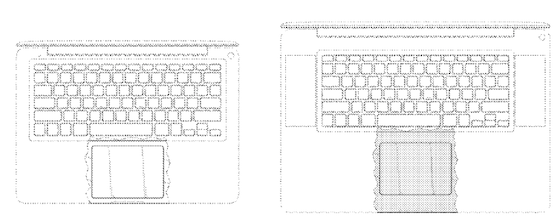When you make what is commonly understood to be the best trackpad hardware in the business, and you're Apple, of course you're going to patent it. There are a couple of ways to go about doing that: file for a technical utility patent, a design patent, or both. Today Apple was awarded a design patent — US D674,382 — for the look (not functionality) of its trackpad housed within a laptop. While it's a relatively broad patent as far as design patents go, it has its limitations, and the drawings define exactly what those are.

The patent illustrations make it clear that only the trackpad and adjacent boundary lines of the laptop are displayed with solid lines. That may be the main focus of the patent coverage, but there's still more to consider. We know Apple's trackpad hardware is constructed of glass and that's part of what's claimed as well — represented by those vertically-angled lines on the surface of the trackpad. Drafting conventions are important in design patent law to help us understand the true scope of a patent, and oblique lines like those are used to represent translucent, highly polished or reflective surfaces. Glass would obviously fit that bill, but so would other similar materials — glass-like polymers, for instance.
Understanding drafting conventions is key to understanding the patent
In addition, there are multiple versions of the trackpad shown in the drawings. Some are presented with a metallic surface over the trackpad, and some with no surface coating at all. Apple has protection for each of those iterations, which could be important if a competitor were to make a glass trackpad (read: touchpad) without an outer coating or layer. This patent might cover that design even though Apple applies a laminate to its actual trackpad products.
Of course, there are a few ways to skirt this particular patent. Apple didn't get a patent on all trackpads, or even all glass trackpads. For example, competitors could add buttons below or above the trackpad. Other non-infringing designs might include recessing the trackpad, or including a larger (or smaller) gap between the trackpad and the front edge of the laptop or the keyboard. Design patents are useful to capture blatant copies but with a little creativity they're often easy to work around. This one's no exception.
:format(webp)/cdn.vox-cdn.com/uploads/chorus_asset/file/14205705/apple-macbook-stock-logo_1020.1419979194.jpeg)